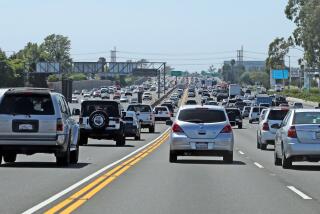Editorial: Automatic braking on U.S. cars will save lives. Biden is right to require it

- Share via
By the end of the decade, new cars and trucks in the United States will be required to have automatic emergency braking systems that can save hundreds of lives each year.
The National Highway Traffic Safety Administration, which announced the requirement Monday, called it the most significant safety rule in two decades. This is an important milestone. But why did it take so long? This technology has been available for years, though often sold as a luxury feature.
Good for European safety ratings group for pushing carmakers to return to manual controls for some car functions. U.S. should do the same. That seems to be what customers want and it’s safer too.
Most automakers voluntarily include some form of automatic braking in new models, but the capabilities can vary. The regulation makes the technology mandatory by 2029 and sets a minimum standard that all cars must be able stop and avoid contact with the vehicle in front of them when traveling up to 62 miles per hour.
Carmakers have been slower to install automatic braking designed specifically to detect and avoid pedestrians, a problem because pedestrian fatalities have been increasing in recent years. The regulation will require that vehicles be able to avoid hitting pedestrians when traveling up to 40 mph and detect pedestrians in the dark, which is when more than three-quarters of such fatalities occur.
The entire transportation system, from road engineering to vehicle design, needs to be planned to avoid crashes and to reduce serious injury and death when crashes occur.
Since the 1980s, the number of people killed each year in car crashes in the U.S. has declined, thanks in part to safety requirements such as seat belts and airbags. That decline in fatalities stalled a decade ago, and traffic death spiked in 2020 and 2021. Experts attribute the rise to an increase in speeding and reckless and distracted driving.
Automatic braking is projected to save about 360 deaths a year, a small but necessary drop. There were 41,000 vehicle fatalities in 2023.
While humans deserve the blame for dangerous driving, there is growing recognition that engineering and technology, from cars to roads, can prevent crashes and reduce the likelihood of serious injury and death when they occur.
Automatic braking is great, but it’s just one safety feature. The federal government should be far more aggressive in promoting and requiring othes; limiting heavier, taller trucks and SUVs that take longer to stop and strike with more force; and reducing reliance on dashboard touch screens that require drivers to take their eyes off the road.
The U.S. military shouldn’t squash antiwar protests on college campuses, no matter what House Speaker Mike Johnson and other Republican politicians say.
Last year, the National Transportation Safety Board recommended — it doesn’t have the power to require — that all new cars have systems to alert drivers when they are speeding. Such systems are required for new cars sold in the European Union starting in July.
California state Sen. Scott Wiener (D-San Francisco) this year proposed requiring technology that automatically slows speeding drivers, but his bill was revised to require a speeding warning instead.
There is no reason for Americans to tolerate 41,000 traffic deaths a year. Most are preventable, and there are tools and design features available to make vehicles safer for everyone on the road. We just have to demand them.
More to Read
A cure for the common opinion
Get thought-provoking perspectives with our weekly newsletter.
You may occasionally receive promotional content from the Los Angeles Times.













